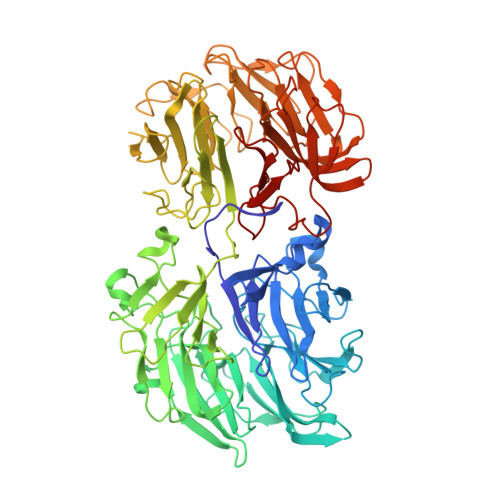Substrate specificity, regiospecificity, and processivity in glycoside hydrolase family 74.
Arnal, G., Stogios, P.J., Asohan, J., Attia, M.A., Skarina, T., Viborg, A.H., Henrissat, B., Savchenko, A., Brumer, H.(2019) J Biol Chem 294: 13233-13247
- PubMed: 31324716
- DOI: https://doi.org/10.1074/jbc.RA119.009861
- Primary Citation of Related Structures:
6P2K, 6P2L, 6P2M, 6P2N, 6P2O - PubMed Abstract:
Glycoside hydrolase family 74 (GH74) is a historically important family of endo -β-glucanases. On the basis of early reports of detectable activity on cellulose and soluble cellulose derivatives, GH74 was originally considered to be a "cellulase" family, although more recent studies have generally indicated a high specificity toward the ubiquitous plant cell wall matrix glycan xyloglucan. Previous studies have indicated that GH74 xyloglucanases differ in backbone cleavage regiospecificities and can adopt three distinct hydrolytic modes of action: exo , endo -dissociative, and endo -processive. To improve functional predictions within GH74, here we coupled in-depth biochemical characterization of 17 recombinant proteins with structural biology-based investigations in the context of a comprehensive molecular phylogeny, including all previously characterized family members. Elucidation of four new GH74 tertiary structures, as well as one distantly related dual seven-bladed β-propeller protein from a marine bacterium, highlighted key structure-function relationships along protein evolutionary trajectories. We could define five phylogenetic groups, which delineated the mode of action and the regiospecificity of GH74 members. At the extremes, a major group of enzymes diverged to hydrolyze the backbone of xyloglucan nonspecifically with a dissociative mode of action and relaxed backbone regiospecificity. In contrast, a sister group of GH74 enzymes has evolved a large hydrophobic platform comprising 10 subsites, which facilitates processivity. Overall, the findings of our study refine our understanding of catalysis in GH74, providing a framework for future experimentation as well as for bioinformatics predictions of sequences emerging from (meta)genomic studies.
Organizational Affiliation:
Michael Smith Laboratories, University of British Columbia, 2185 East Mall, Vancouver, British Columbia V6T 1Z4, Canada.

















